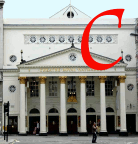
Caricature of Freake by "T" (Théobald Chartran) in Vanity Fair on 31 March 1883. [Click on all the images for more information about them, and to see larger versions.]

harles James Freake (1814-1884) came from a poor background. The son of a publican, he began life as a carpenter, but his entrepreneurial skill and forceful personality soon raised him to be a major player in the great building boom during Queen Victoria's reign.
Freake began his upward trajectory in 1838 building a few houses in Belgravia, but soon moved to develop Princes Gate in Kensington with substantial terraces to attract rich leaseholders. During the next fifty years he was the main contractor responsible for the continued expansion of South Kensington. Eaton Square, Onslow Square, Fulham Road, Cromwell Road and their environs were all laid out by him with sewers, communal gardens, mews stables and shops. Altogether Freake built more than five hundred large leasehold houses with elaborate internal fixings; some of these dwellings appear in census returns with up to ten servants (see Sheppard, Vol. XL1). Three neighbourhood churches, not designed by Freake, were constructed by him and every scrap of land was put to good use. In Sydney Mews, behind Onslow Square, there was an awkward triangular space in which the sculptor Marochetti established his foundry: later a range of studios here were used by other famous sculptors and artists, including the sculptors Sir Edgar Boehm and Arthur Gilbert, and the painter John Singer Sargent.



Left to right: (a) Onslow Square, south side. (b) The Royal College of Organists. (c) Linley Sambourne's cartoon of Freake in Punch as a hands-on builder in a high position (on a ladder, pulled up by his generosity to the Prince of Wales).
Freake became rich and famous but gave generously to philanthropic causes: he especially loved music and at his own expense built the National Training School for Music in 1875 (next to the Albert Hall, later named the Royal College of Organists). Its use was given free for five years and in 1878 Freake made over all his rights in the building to the Prince of Wales. For this generosity he was given a baronetcy in 1882.
Freake and his wife moved between various houses as each new area was completed, ending up at 21 Cromwell Road. They enjoyed entertaining, especially musical evenings which were very popular among the couple's wealthy and well-connected friends. But Freake never became gentrified or lost his down to earth characteristics: it is said that his more genteel wife did not urge him to speak better but adopted his cockney accent for herself. In spite of many philanthropic donations he still left a fortune at his death of more than £718,000 (Sheppard, Vol. XXXVIII), around 80 million in today's money.
Bibliography
"Domestic Buildings after 1851: The Italianate Tradition. Survey of London, Vol. 38, South Kensington Museums Area. Ed. F.H.W. Sheppard. London, 1975: 262-307. British History Online. Web. 1 February 2024.
"The Royal College of Organists." Survey of London, Vol. 38, South Kensington Museums Area. Ed. F.H.W. Sheppard. London, 1975: 217-219. British History Online. Web. 1 February 2024.
"The Smith's Charity Estate: Charles James Freake and Onslow Square Gardens." Survey of London, Vol. 41, ed. F.H.W. Sheppard (1983): 101-17. Web. 1 February 2024.
Created 2 February 2024